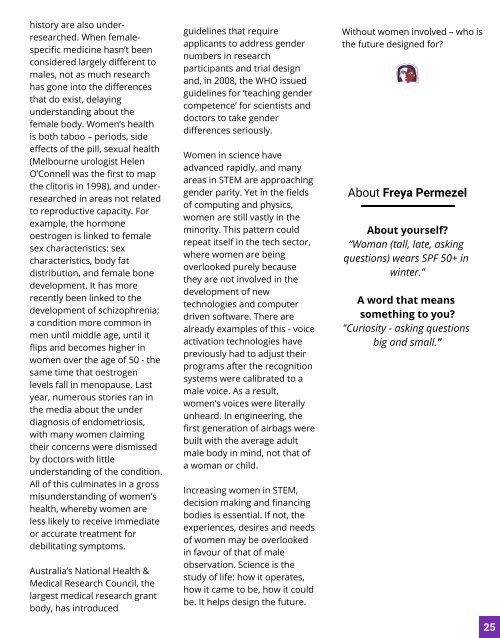TLWmaga4-compressed (1)
Create successful ePaper yourself
Turn your PDF publications into a flip-book with our unique Google optimized e-Paper software.
history are also underresearched.<br />
When femalespecific<br />
medicine hasn’t been<br />
considered largely different to<br />
males, not as much research<br />
has gone into the differences<br />
that do exist, delaying<br />
understanding about the<br />
female body. Women’s health<br />
is both taboo – periods, side<br />
effects of the pill, sexual health<br />
(Melbourne urologist Helen<br />
O’Connell was the first to map<br />
the clitoris in 1998), and underresearched<br />
in areas not related<br />
to reproductive capacity. For<br />
example, the hormone<br />
oestrogen is linked to female<br />
sex characteristics: sex<br />
characteristics, body fat<br />
distribution, and female bone<br />
development. It has more<br />
recently been linked to the<br />
development of schizophrenia;<br />
a condition more common in<br />
men until middle age, until it<br />
flips and becomes higher in<br />
women over the age of 50 - the<br />
same time that oestrogen<br />
levels fall in menopause. Last<br />
year, numerous stories ran in<br />
the media about the under<br />
diagnosis of endometriosis,<br />
with many women claiming<br />
their concerns were dismissed<br />
by doctors with little<br />
understanding of the condition.<br />
All of this culminates in a gross<br />
misunderstanding of women’s<br />
health, whereby women are<br />
less likely to receive immediate<br />
or accurate treatment for<br />
debilitating symptoms.<br />
Australia’s National Health &<br />
Medical Research Council, the<br />
largest medical research grant<br />
body, has introduced<br />
guidelines that require<br />
applicants to address gender<br />
numbers in research<br />
participants and trial design<br />
and, in 2008, the WHO issued<br />
guidelines for ‘teaching gender<br />
competence’ for scientists and<br />
doctors to take gender<br />
differences seriously.<br />
Women in science have<br />
advanced rapidly, and many<br />
areas in STEM are approaching<br />
gender parity. Yet in the fields<br />
of computing and physics,<br />
women are still vastly in the<br />
minority. This pattern could<br />
repeat itself in the tech sector,<br />
where women are being<br />
overlooked purely because<br />
they are not involved in the<br />
development of new<br />
technologies and computer<br />
driven software. There are<br />
already examples of this - voice<br />
activation technologies have<br />
previously had to adjust their<br />
programs after the recognition<br />
systems were calibrated to a<br />
male voice. As a result,<br />
women’s voices were literally<br />
unheard. In engineering, the<br />
first generation of airbags were<br />
built with the average adult<br />
male body in mind, not that of<br />
a woman or child.<br />
Increasing women in STEM,<br />
decision making and financing<br />
bodies is essential. If not, the<br />
experiences, desires and needs<br />
of women may be overlooked<br />
in favour of that of male<br />
observation. Science is the<br />
study of life: how it operates,<br />
how it came to be, how it could<br />
be. It helps design the future.<br />
Without women involved – who is<br />
the future designed for?<br />
About Freya Permezel<br />
About yourself?<br />
“Woman (tall, late, asking<br />
questions) wears SPF 50+ in<br />
winter.”<br />
A word that means<br />
something to you?<br />
"Curiosity - asking questions<br />
big and small."<br />
25



